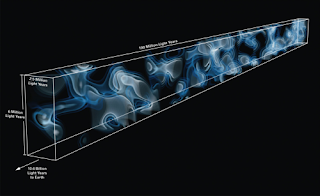 |
| Cosmic Web, Open Science |
***
First of all, astronomers report an observed phenomenon called the cosmic web. The article It's Filamentary says more, includingThe distribution of galaxies and matter in the universe is non-random. Galaxies are organized, even today, in a manner resembling an enormous network – the cosmic web. This web has dense regions made up of galaxy clusters and groups, sparsely populated regions devoid of galaxies, as well as the filaments that link overdense regions.
“The filaments are like bridges connecting the denser regions in the cosmic web,” [Benham] Darvish explained. “Imagine threads woven into the web.”Here's a 3D image of the cosmic web, posted at Dave Reneke's World of Space and Astronomy.
***
 |
| The Cosmic Web in 3D, davidreneke |
***
Physics Today reported last week that astronomers observe a nascent galaxy stuck to the cosmic web.
***
 |
| Nascent galaxy in cosmic web, Physics Today |
***
The article mentions a cosmic web imager. To see the lab setup, browse to Caltech's CWI page. Unfortunately, the photos are small. Here's a paper (PDF format) with larger images and some more information: The Keck Cosmic Web Imager.
Spectrography, interchangeable with spectroscopy, is the method used to observe this type of web. According to Wikipedia--
Spectroscopy and spectrography are terms used to refer to the measurement of radiation intensity as a function of wavelength and are often used to describe experimental spectroscopic methods. Spectral measurement devices are referred to as spectrometers, spectrophotometers, spectrographs or spectral analyzers.For a more granular definition, check out Spectrometer, Spectroscope, and Spectrograph in SPIE's Optipedia. SPIE is an international society advancing an interdisciplinary approach to the science and application of light.
-- Marge

No comments:
Post a Comment